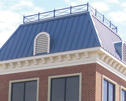In April, FM Global published an updated version of its Property Loss Prevention Data Sheet 1-52 (FM 1-52), "Field Uplift Tests." If you are involved with roofing projects that specify compliance with FM Global's guidelines, you should be aware of FM 1-52's changes.
Revisions
The most significant change to FM 1-52 is field uplift testing no longer is recommended for new roof covers that are mechanically fastened directly to certain roof deck types provided the roof cover fastener spacing is verified as adequate; FM Global indicates fastener spacing can be verified by visual examination or nondestructive examination. According to FM Global, the roof deck types with this testing exemption are steel (minimum 22 gauge), wood, cementitious wood fiber plank and structural concrete (minimum 2,500 pounds per square inch of compressive strength).
For wide rib steel roof decks where the test pressure exceeds 60 pounds per square foot (psf), FM Global now allows an additional 1/4-inch deflection from the previously allowed deflection limit for each 60-psf increment of test pressure. If an intermediate or narrow rib steel roof deck is used, FM Global now permits the allowable deflection limit to be twice the previous allowable deflection limit up to a maximum 1-inch deflection.
Also, FM Global recommends that any rooftop observers not directly involved with operating test equipment should not stand immediately adjacent to a test area during testing. In addition, FM 1-52 now indicates "it is imperative that there be no walking near the test area between the time the deflection gauge has been zeroed out and the test is complete."
Other changes to FM 1-52 provide additional guidance for interpreting test results. If all FM 1-52 test results indicate all measured deflections are within the recommended allowable limits, FM Global considers the roof to be acceptable from a wind-uplift performance perspective.
FM 1-52 indicates it is not uncommon for some roofs to pass the test and others to fail. For single-ply membranes adhered to mechanically attached insulation, FM Global recommends visually identifying the fastener densities and patterns. If the fastener densities and patterns are similar, FM Global considers the roof area that passes the test to be acceptable from a wind-uplift performance perspective.
In other instances (using non-single-ply membranes) where some roof systems have passed and others failed, FM Global suggests conducting additional tests to more clearly determine the areas that may need supplemental securement.
NRCA's viewpoint
NRCA continues to strongly oppose field uplift testing, such as FM 1-52, as a measure of quality assurance for low-slope roof system application. The test method's variability and lack of repeatability and operator sensitivity, as well as lack of correlation between such test data and FM Global's laboratory-derived approval classifications, make data and results from FM 1-52 testing noncredible.
Some of FM 1-52's latest revisions indicate FM Global is beginning to recognize roof deck deflection's influence on FM 1-52's test results. Because a roof deck's design, installation and deflection are not controlled by the roof system applicator, this further indicates FM 1-52 is not appropriate as a roof application quality-assurance measure.
Also, FM Global's recommendation that there be no movement near the test apparatus between the time the deflection gauge is zeroed out and when the test is complete is not feasible with some of the equipment and procedures used during the tests.
NRCA maintains—as it has for years—the most effective way to ensure the quality of a low-slope roof system application is continuous visual monitoring of the application process during roof system installation.
Mark S. Graham is NRCA's associate executive director of technical services.



